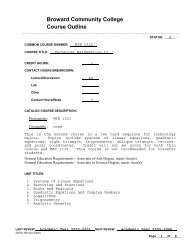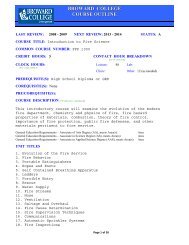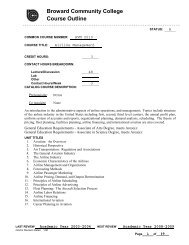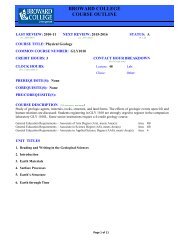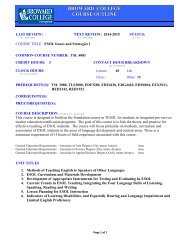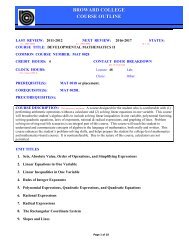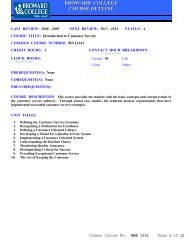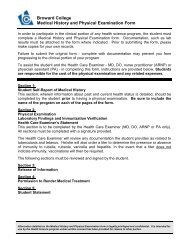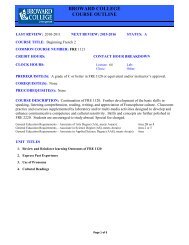Course Outline Information
Course Outline Information
Course Outline Information
You also want an ePaper? Increase the reach of your titles
YUMPU automatically turns print PDFs into web optimized ePapers that Google loves.
Broward Community College<strong>Course</strong> <strong>Outline</strong>COMMON COURSE NUMBER:MSS 0156LSTATUS:ACOURSE TITLE:Anatomy & Physiology for Massage Therapy IILabCONTACT HOURS: 60CONTACT HOUR BREAKDOWN:Lecture/Discussion: 00Laboratory: 60Other 00Contact hours/week: 4CATALOG COURSE DESCRIPTION:<strong>Course</strong> provides integration of neuromusculoskeletal anatomy into therapeutic application ofmassage. Massage techniques are presented sequentially with review of positioning,appropriate strokes, ethical situations, appropriate draping, etc. Throughout the course,charting and interviewing skills are taught and practiced.PREREQUISITE(S):COREQUISITE(S):nonenoneUNIT TITLES:1.0 Anatomy Terminology2.0 Osteology Overview3.0 Arthrology Overview4.0 Neurology Overview5.0 Myology Overview6.0 Osteology and Myology of the Skull and VertebralColumn7.0 Osteology and Myology of Trunk, Pelvis and LowerExtremity8.0 Osteology and Myology of the Upper ExtremityLAST REVIEW Academic Year 2001-2002 NEXT REVIEW Academic Year 2006-07Interim Revision Dates:
Instructional OutcomesUpon successful completion of this course, the students will be able to detail specificsregarding osteology and myology so that massage procedures may be skillfully applied.In addition, as detailed in the General Outcomes for each Unit Title, the student will:1. Discuss the basic relationships of body parts in correct anatomic terminology.2. Describe basic skeletal histology.3. Discuss the basic parts of bone, muscle and joints using correct anatomic terminologyto classify joints.4. Relate the basic function and structure of the nervous system as it relates tomovement.5. Describe basic muscular histology.6. Identify major bones, joints, muscles, actions and innervations of the skull andvertebral column.7. Identify major joints, bones, muscles actions and innervations of the trunk, pelvis andlower extremity.8. Identify major joints, bones, muscles actions and innervations of the trunk, pelvis andupper extremity.9. Demonstrate ability to correctly identify through visual and palpatory skills muscles,tendons, nerve pathways, and joint structures through the use of surface anatomy.Behavioral OutcomesUpon successful completion of this course, the student will:1. Demonstrate a receptive response to constructive criticism as provided via examinations,quizzes, and assigned projects related to the subject matter.2. Demonstrate conduct that reflects respect and courtesy in all interactions withinstructor(s) and peers.3. Engage in on-going self-assessment as it relates to achieving success in the course sothat content areas that require knowledge enhancement can be identified.4. Set appropriate goals as a result of on-going self-assessment.MSS 0156L: Anatomy and Physiology for Massage Therapy Lab Page 2 of 10
UNIT 1ANATOMIC TERMINOLOGYGeneral Outcome:1.0 The student will discuss the basic relationships of body parts in correct anatomicterminology.Specific Instructional Objectives:Upon successful completion of this unit, the student will be able to:1.1 List the synonyms for general body regions.1.2 Name the synonyms for body surfaces.1.3 Draw the plans of the body.1.4 Demonstrate or identify movements at certain joints of the body.MSS 0156L: Anatomy and Physiology for Massage Therapy Lab Page 3 of 10
UNIT 2OSTEOLOGY OVERVIEWGeneral Outcome:2.0 The student will be able to describe basic skeletal histology.Specific Instructional Objectives:Upon successful completion of this unit, the student will be able to:2.1 List the components that comprise the human system.2.2 Identify epithelia, connective, tendon, ligament, cartilage as tissue types.2.3 Detail the function of each of the above.2.4 List the various types of connective tissue.2.5 Identify characteristics of bone, matrix, spongy bone, compact bone.2.6 Identify stages of bone during early, middle, and late life.2.7 List the characteristics of bone.2.8 Define diaphysis, epiphysis, articular cartilage, periosteum (inner and outerlayer), medullary cavity, endosteum.2.9 Discuss the characteristics of spongy and compact bone.2.10 Compare and contrast spongy and compact bone.2.11 Define osteogenesis.2.12 Write the definition of cartilage.2.13 Name the three (3) types of cartilage.2.14 Identify the names of the various types of cartilage growth.MSS 0156L: Anatomy and Physiology for Massage Therapy Lab Page 4 of 10
UNIT 3ARTHROLOGY OVERVIEWGeneral Outcome:3.0 The student will be able to discuss the basic parts of bone, muscle and joints usingcorrect anatomic terminology to classify joints.Specific Instructional Objectives:Upon successful completion of this unit, the student will be able to:3.1 Write the definition of a joint.3.2 Draw the spectrum of joints from immovable to freely movable.3.3 Identify examples of fibrous, cartilage, and synovial joints.3.4 List the types of synovial joints.3.5 Write an example of each synovial joint and characteristics of each.3.6 Describe the articular capsule and identify its role in synovial joints.MSS 0156L: Anatomy and Physiology for Massage Therapy Lab Page 5 of 10
UNIT 4NEUROLOGY OVERVIEWGeneral Outcome:4.0 The student will be able to relate the basic function and structure of the nervous systemas it relates to movement..Specific Instructional Objectives:Upon successful completion of this unit, the student will be able to:4.1 Define basic structure of nervous system.4.2 Review the components of the brachial plexus and the lumbosacral plexus.MSS 0156L: Anatomy and Physiology for Massage Therapy Lab Page 6 of 10
UNIT 5MYOLOGY OVERVIEWGeneral Outcome:5.0 The student will be able to describe basic muscle histology.Specific Instructional Objectives:Upon successful completion of this unit, the student will be able to:5.1 Identify histologic aspects of muscle tissue.5.2 Discuss the physiology of muscle contraction.5.3 Explain the function of the muscle spindle.5.4 Define origin and insertion and their significance in muscle contractions.MSS 0156L: Anatomy and Physiology for Massage Therapy Lab Page 7 of 10
UNIT 6OSTEOLOGY AND MYOLOGY – SKULL/VERTEBRAL COLUMNGeneral Outcome:6.0 The student will be able to identify major bones, joints, muscles, actions andinnervations of the skull and vertebral column.Specific Instructional Objectives:Upon successful completion of this unit, the student will be able to:6.1 List the two main portions of the skull.6.2 Identify major bony landmarks of the skull.6.3 Describe the structure and function of the vertebra.6.4 List the number of vertebra at each level.6.5 Identify all listed bony landmarks.6.6 Describe the characteristic differences between all types of vertebra.6.7 Identify the above differences on actual bone samples.6.8 List the primary and secondary curves of the spinal column.6.9 Discuss how the curves above develop.6.10 List the types of joints located in the spinal column.6.11 List the ligaments of the spinal column.6.12 identify main muscles of the head and neck region.6.13 Relate origins, insertions and actions of each muscle.6.14 Identify innervation to each muscle.MSS 0156L: Anatomy and Physiology for Massage Therapy Lab Page 8 of 10
UNIT 7OSTEOLOGY AND MYOLOGY - TRUNK, PELVIS/LEGeneral Outcome:7.0 The student will be able to identify major joints, bones, muscles actions andinnervations of the trunk, pelvis and lower extremity.Specific Instructional Objectives:Upon successful completion of this unit, the student will be able to:7.1 Identify the bony pelvis.7.2 Identify all twelve (12) listed bony landmarks and discuss their importance.7.3 Demonstrate the movement of the pelvis.7.4 Identify main muscles of the trunk.7.5 Relate origins, insertions and actions of each muscle.7.6 Identify innervation to each muscle.7.7 Identify and list the general characteristics of the femur.7.8 Identify all eight (8) landmarks of the femur.7.9 Identify the characteristics of the tibia and the fibula.7.10 Demonstrate the movements of the tibia and fibula.7.11 Identify the listed landmarks of the tibia and fibula.7.12 Discuss the characteristics of the ankle joint.7.13 Identify the ankle landmarks.7.14 Identify and demonstrate the four (4) movements of the ankle.7.15 Identify the landmarks of the foot.7.16 Describe injury to the ankle, in particular, of the ligaments.7.17 Identify main muscles of the lower extremity.7.18 Relate origins, insertions and actions of each muscle.7.19 Identify innervations to each muscle.MSS 0156L: Anatomy and Physiology for Massage Therapy Lab Page 9 of 10
UNIT 8 OSTEOLOGY AND MYOLOGY - UPPER EXTREMITYGeneral Outcome:8.0 The student will be able to identify major joints, bones, muscles actions andinnervations of the upper extremity.Specific Instructional Objectives:Upon successful completion of this unit, the student will be able to:8.1 Identify the major characteristics of the shoulder.8.2 Identify and list the importance of the landmarks of the shoulder complex.8.3 Demonstrate the movements of the shoulder.8.4 Identify the contribution of the scapula, clavicle and sternum to shouldermovements.8.5 List the joints that comprise the shoulder complex.8.6 List the characteristics of the humerus.8.7 Identify and list the landmarks of the humerus.8.8 Discuss the humeral contribution to the shoulder and elbow joints.8.9 Identify the characteristics of the radius and ulna.8.10 Identify and list the landmarks of the radius and ulna.8.11 Discuss the articulations that involve the radius and ulna at the elbow/wrist.8.12 List the characteristics of the wrist/hand complex.8.13 Identify and list the landmarks of the wrist/hand,8.14 Discuss the significance of the joints of the wrist complex and of the digits.8.15 Identify the innervations of each muscle that involves the upper extremity.8.16 Relate the muscular movements of the upper extremity to function.8.17 Identify main muscles of the upper extremity.8.18 Relate origins, insertions and actions of each muscle.MSS 0156L: Anatomy and Physiology for Massage Therapy Lab Page 10 of 10



